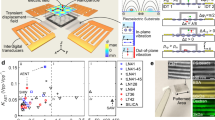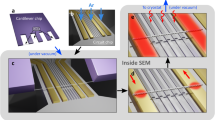Abstract
The development of manipulation tools that are not too ‘fat’ or too ‘sticky’ for atomic scale assembly is an important challenge facing nanotechnology1. Impressive nanofabrication capabilities have been demonstrated with scanning probe manipulation of atoms2,3,4,5 and molecules4,6 on clean surfaces. However, as fabrication tools, both scanning tunnelling and atomic force microscopes suffer from a loading deficiency: although they can manipulate atoms already present, they cannot efficiently deliver atoms to the work area. Carbon nanotubes, with their hollow cores and large aspect ratios, have been suggested7,8 as possible conduits for nanoscale amounts of material. Already much effort has been devoted to the filling of nanotubes8,9,10,11 and the application of such techniques12,13. Furthermore, carbon nanotubes have been used as probes in scanning probe microscopy14,15,16. If the atomic placement and manipulation capability already demonstrated by scanning probe microscopy could be combined with a nanotube delivery system, a formidable nanoassembly tool would result. Here we report the achievement of controllable, reversible atomic scale mass transport along carbon nanotubes, using indium metal as the prototype transport species. This transport process has similarities to conventional electromigration, a phenomenon of critical importance to the semiconductor industry17,18.
This is a preview of subscription content, access via your institution
Access options
Subscribe to this journal
Receive 51 print issues and online access
$199.00 per year
only $3.90 per issue
Buy this article
- Purchase on Springer Link
- Instant access to full article PDF
Prices may be subject to local taxes which are calculated during checkout




Similar content being viewed by others
References
Service, R. F. Is nanotechnology dangerous? Science 290, 1526–1527 (2000)
Eigler, D. M. & Schweizer, E. K. Positioning single atoms with a scanning tunnelling microscope. Nature 344, 524–526 (1990)
Crommie, M. F., Lutz, C. P. & Eigler, D. M. Confinement of electrons to quantum corrals on a metal surface. Science 262, 218–220 (1993)
Bartels, L., Meyer, G. & Rieder, K. H. Basic steps of lateral manipulation of single atoms and diatomic clusters with a scanning tunneling microscope tip. Phys. Rev. Lett. 79, 697–700 (1997)
Oyabu, N., Custance, O., Yi, I. S., Sugawara, Y. & Morita, S. Mechanical vertical manipulation of selected single atoms by soft nanoindentation using near contact atomic force microscopy. Phys. Rev. Lett. 90, 176102 (2003)
Heinrich, A. J., Lutz, C. P., Gupta, J. A. & Eigler, D. M. Molecule cascades. Science 298, 1381–1387 (2002)
Kral, P. & Tomanek, D. Laser-driven atomic pump. Phys. Rev. Lett. 82, 5373–5376 (1999)
Supple, S. & Quirke, N. Rapid imbibition of fluids in carbon nanotubes. Phys. Rev. Lett. 90, 214501 (2003)
Ajayan, P. M. & Iijima, S. Capillarity-induced filling of carbon nanotubes. Nature 361, 333–334 (1993)
Dujardin, E., Ebbesen, T. W., Hiura, H. & Tanigaki, K. Capillarity and wetting of carbon nanotubes. Science 265, 1850–1852 (1994)
Pederson, M. R. & Broughton, J. Q. Nanocapillarity in fullerene tubules. Phys. Rev. Lett. 69, 2689–2692 (1992)
Gao, Y. H. & Bando, Y. Carbon nanothermometer containing gallium. Nature 415, 599 (2002)
Ugarte, D., Chatelain, A. & deHeer, W. A. Nanocapillarity and chemistry in carbon nanotubes. Science 274, 1897–1899 (1996)
Wong, S. S., Joselevich, E., Woolley, A. T., Cheung, C. L. & Lieber, C. M. Covalently functionalized nanotubes as nanometre-sized probes in chemistry and biology. Nature 394, 52–55 (1998)
Wong, S. S., Harper, J. D., Lansbury, P. T. & Lieber, C. M. Carbon nanotube tips: High-resolution probes for imaging biological systems. J. Am. Chem. Soc. 120, 603–604 (1998)
Dai, H. J., Hafner, J. H., Rinzler, A. G., Colbert, D. T. & Smalley, R. E. Nanotubes as nanoprobes in scanning probe microscopy. Nature 384, 147–150 (1996)
Pierce, D. G. & Brusius, P. G. Electromigration: a review. Microelectron. Reliab. 37, 1053–1072 (1997)
Collins, P. G., Hersam, M., Arnold, M., Martel, R. & Avouris, P. Current saturation and electrical breakdown in multiwalled carbon nanotubes. Phys. Rev. Lett. 86, 3128–3131 (2001)
Cumings, J. P. Electrical and Mechanical Properties of Carbon and Boron Nitride Nanotubes. Ph.D. thesis, Univ. California, Berkeley (2002)
Adamson, A. W. & Gast, A. P. Physical Chemistry of Surfaces (Wiley, New York, 1997)
Duclaux, L. Review of the doping of carbon nanotubes (multiwalled and single-walled). Carbon 40, 1751–1764 (2002)
Zinke-Allmang, M. Phase separation on solid surfaces: nucleation, coarsening and coalescence kinetics. Thin Solid Films 346, 1–68 (1999)
Hummel, R. E. Electromigration and related failure mechanisms in integrated-circuit interconnects. Int. Mater. Rev. 39, 97–111 (1994)
Kral, P. & Shapiro, M. Nanotube electron drag in flowing liquids. Phys. Rev. Lett. 86, 131–134 (2001)
Ghosh, S., Sood, A. K. & Kumar, N. Carbon nanotube flow sensors. Science 299, 1042–1044 (2003)
Mingo, N., Yang, L. & Han, J. Current-induced forces upon atoms adsorbed on conducting carbon nanotubes. J. Phys. Chem. B 105, 11142–11147 (2001)
Yasunaga, H. & Natori, A. Electromigration on semiconductor surfaces. Surf. Sci. Rep. 15, 205–280 (1992)
Kono, S., Goto, T., Ogura, Y. & Abukawa, T. Surface electromigration of metals on Si(001): In/Si(001). Surf. Sci. 420, 200–212 (1999)
Acknowledgements
We thank K. Jensen and S. Rochester for assistance with graphics. This research was supported in part by the US Department of Energy and the National Science Foundation.
Author information
Authors and Affiliations
Corresponding author
Ethics declarations
Competing interests
The authors declare that they have no competing financial interests.
Supplementary information
Supplementary Movie
This shows the mass transport process as observed in the transmission electron microscope. Driving an electrical current through the nanotube induces indium transport from particle to particle. (MP4 1501 kb)
Rights and permissions
About this article
Cite this article
Regan, B., Aloni, S., Ritchie, R. et al. Carbon nanotubes as nanoscale mass conveyors. Nature 428, 924–927 (2004). https://doi.org/10.1038/nature02496
Received:
Accepted:
Issue Date:
DOI: https://doi.org/10.1038/nature02496
This article is cited by
-
Vibration response of viscoelastic perforated higher-order nanobeams rested on an elastic substrate under moving load
Acta Mechanica (2024)
-
Toward Directional Motion on Graphene by Uniaxial Strain
Iranian Journal of Science and Technology, Transactions of Mechanical Engineering (2023)
-
Mass transport induced structural evolution and healing of sulfur vacancy lines and Mo chain in monolayer MoS2
Rare Metals (2022)
-
Towards nanoprinting with metals on graphene
Nature Communications (2015)
-
Molecular mobility on graphene nanoroads
Scientific Reports (2015)
Comments
By submitting a comment you agree to abide by our Terms and Community Guidelines. If you find something abusive or that does not comply with our terms or guidelines please flag it as inappropriate.



